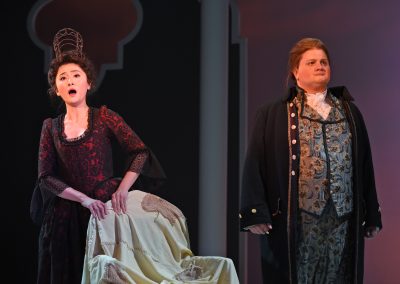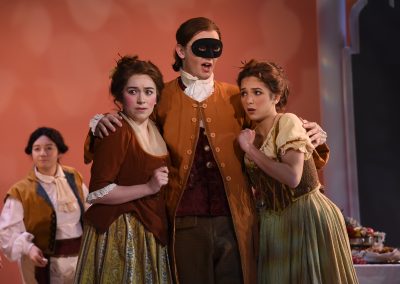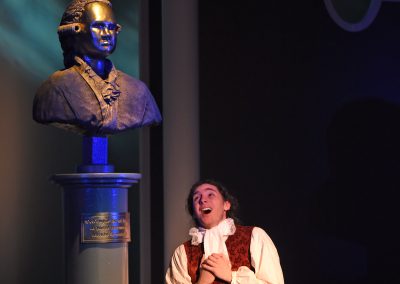
Creative Team
Conductor
Martin Katz
Stage Director
Mo Zhou
Scenic Designer
Jungah Han
Costume Designer
Sarah M. Oliver
Lighting Designer
Rob Murphy
Wig Designer
Amanda Miller
Wig Supervisor
Mary Lee
Italian Diction Coach
Timothy Cheek
Dramaturg
Karin Waidley
Répétiteurs & Cembalists
Julian Grabarek‡, Sarah Thune‡
Fight Director
Atticus Olivet‡
Intimacy Director
Lauren Lenz
Production Stage Manager
Kayleigh Laymon
Assistant Conductor
Aleksandr Polyakov‡*
*Aleksandr Polyakov will conduct the performance on Sunday, March 26.
‡SMTD Student
Cast
Thursday/Saturday
Don Giovanni, a libertine
Taewon Sohn
Leporello, Don Giovanni’s servant
Tyler Middleton
Donna Anna, Il Commendatore’s daughter
Sitong Liu
Donna Elvira, a lady of Burgos, abandoned by Don Giovanni
Aria Minasian
Don Ottavio, Donna Anna’s betrothed
Trevor Scott
Zerlina, a peasant girl
Danielle Casós
Masetto, Zerlina’s betrothed
Amante Pando Girard
Friday/Sunday
Don Giovanni, a libertine
Andrew Smith
Leporello, Don Giovanni’s servant
Jack Morin
Donna Anna, Il Commendatore’s daughter
Bethany Worrell
Donna Elvira, a lady of Burgos, abandoned by Don Giovanni
HaYoung Jung
Don Ottavio, Donna Anna’s betrothed
Yinghui “Mark” He
Zerlina, a peasant girl
Catherine Gispert
Masetto, Zerlina’s betrothed
Cody Carlson
All Performances
Il Commendatore
Joshua Thomas
Ensemble
Hallie Ackerman, Sohyun Cho, Suri Doepfer, Alexandra (Sasha) Gusikhin, Jamiyah Hudson, Micah Huisman, Justin Ingui, Kelsey Keenan, Xavier Perry, Victoria Rose Pinto, Marisa Redding, Madeleine Surowiec, Sarah Wallace, Chase Warren, Hannah Yan
Orchestra
Violin I Cameron Jeppson**, Gloria Hsieh, Albert Li, Anna Linder, Bradley Smith, Bryce Yung
Violin II Anda Jiang*, Caleb Frailey, Joseph Kim, Evan Schuman
Viola Katie Snelling*, Mateo Calderon, Julia Daniels, Joseph Reichelt
Cello Matthew Averyt*, Peter Falb, Cal Walrath
Double Bass Abimelec Guerra*, Ava Chupp
Flute Abi Middaugh, Ting-Yu Yeh
Oboe Jonathan Chan, Jonathan Krause
Clarinet Oliver Bishop, Timothy Kulawiak
Bassoon Chasten Musenda, Benjamin Weppler
Trumpet Evelyn Hartman, Thomas Welch
Horn Aidan Frohock, Joseph Murphy
Trombone Aiden Drysdale, Aryn Nester
Bass Trombone Ryan Meyaard
Timpani Spencer Perilloux
Mandolin Nicholas Cook
Assistants to the Creative Team
Assistant Director Andrew Smith‡ | Assistant Lighting Designer William Webster‡
Co-Dramaturg Leo Kupferberg‡ | 1st ASM Elaina Veasey‡
2nd ASMs Chuck Gibson‡, Katie Kutzko‡, Caleb Quezon‡
Production Crew
Sound Engineer Roger Arnett
Hair and Makeup Supervisor Sam Whetstone
Assistant Master Electrician Brandon Malin
Shop Crews
Theatrical Lighting Abi Farnsworth, Jordan Pinet, Brandon Malin, Christian Mulville, Sydney Geysbeek, Elianna Kruskal, Megan Mondek, Alex Li, William Webster
Painting Ellie Vice & Theatre 250/252/261 students
Props Beatrix Dergis, Aquila Ewald, Dallas Fadul, Eli Hubbel, Rachael Hymowitz, Katie Kim, Lucy Knas, Alex Li, Audrey Tieman, Laurence Vance, and Theatre 250/252 students
Scenery (Walgreen Scene Shop) Niamh Sullivan, Sophia Severance, Cass Scott, Andy Blatt, Miles Hionis, Juliet Bornholdt, and Theatre 250/ 252 students
Costumes Esmay Pricejones, Ellie VanEngen, Kaytlin Sanchez, and Theatre 250/252/262 Students
Production Office Holly Adam, Marissa Honig, Trisha Stichler
Running Crew
Light Board Operator Anna Zhou
Supertitles Operator Maya Liu
Followspot Operator Austin Nedrow
Followspot Operator Haoyi Wen
Deck/Props Crew Sofia Deler, Tiara Partsch
Deck/Scenery Crew Brendan Dallaire, Jamie Mann, Diego Rodriguez
Wardrobe Crew Mila McCoy+, Kaitlyn Yi, Alex Humphreys, Lucy Knas
Wig/Makeup Crew Dallas Fadul+, Amy Helms
+Crew Head
Design & Production Faculty Advisors
Head of Design & Production Christianne Myers
Stage Management Nancy Uffner
Scenic Design Jungah Han, Kevin Judge
Costume Design Christianne Myers, Sarah M. Oliver, Christopher Vergara
Lighting Design Jess Fialko, Shelby Loera, Rob Murphy
Sound Design Henry Reynolds
Department of Voice
Chair
Scott Piper
Opera Faculty
Kathleen Belcher, Timothy Cheek, Abbigail Coté, Tara Faircloth (Guest Director), Kirk Severtson, Matthew Thompson, Mo Zhou
Voice Faculty
Freda Herseth, Stephen Lusmann, Caitlin Lynch, Amanda Majeski, Rose Mannino, Stanford Olsen, Scott Piper, George Shirley, Louise Toppin, Daniel Washington, Stephen West
Associated Faculty
Antonio Cuyler, Caroline Helton
Distinguished Visiting Artist
Thomas Hampson
Professors Emeriti
Willis Patterson, Carmen Pelton, George Shirley
University Productions Administrative Staff
Executive Director
Jeffrey Kuras
Administrative Specialist
Christine Eccleston
Administrative Assistant
Nathan Carrillo
Information Systems Manager
Henry Reynolds
Facilities Manager
Shannon Rice
Performance Halls
House Manager
Kelley Krahn
Lead Backstage Operations Manager
Dane Racicot
Senior Backstage Operations Manager
David Pickell
Backstage Operations Managers
Tiff Crutchfield, Alex Gay, Yvette Kashmer
University Productions Production Staff
Production Manager
Paul Hunter
Assistant Production Manager
Michelle Williams-Elias
Technical Director (Walgreen)
Richard W. Lindsay Jr.
Theatrical Scenery Manager
Chad Hain
Lead Scenic Carpenter
Devin Miller
Scenic Carpenter
Heather Udowitz
Charge Scenic Artist
Beth Sandmaier
Associate Theatrical Paint Manager
Madison Stinemetz
Theatrical Properties Manager
Patrick A. Drone
Senior Properties Artisan
Dan Erickson
Theatrical Lighting Manager
Heather Hunter
Associate Theatrical Lighting Manager
Baxter Chambers
Sound Designer/Engineer
Henry Reynolds
Costume Shop Manager
Laura Brinker
Assistant Costume Shop Manager
Leslie Ann Smith
Cutter/Drapers
Justin Collings, Seth Gilbert, TJ Williamson
Theatrical Stitchers
Rene Plante, Marcia Grace
Crafts Artisan
Elizabeth Gunderson
Costume Stock Manager
Theresa Hartman
Wardrobe Manager
Rossella Human
Resources
- About the Performance
- About the Authors
- From the Director
- From the Dramaturgs
- Land Acknowledgment
- Download Program
The performers in this production were students in the Department of Voice and the University Philharmonia Orchestra. The designers for this production were students, faculty, and/or guests of SMTD. Scenery, costumes, properties, sound, and lighting were realized by the students and staff of University Productions, the producing unit of the SMTD. Thank you for supporting our educational mission.
Original Performance
First performance at the National Theater in Prague, October 29, 1787
Setting
Seville, Spain in the eighteenth century.
Supertitles by Brett Finley
Wolfgang Amadeus Mozart (Composer, 1756-1791) was one of the most influential, popular, and prolific composers of the classical period. He composed over 600 works, including some of the most famous and loved pieces of symphonic, chamber, operatic, and choral music. From an early age, the young Mozart showed all the signs of a prodigious musical talent. By the age of 5 he could read and write music, and he would entertain people with his talents on the keyboard. By the age of 6 he was writing his first compositions.
Mozart’s years in Vienna, from age twenty-five to his death at thirty-five, cover one of the greatest developments in a short span in the history of music. In these ten years Mozart’s music grew rapidly beyond the realm of many of his contemporaries; it exhibited both ideas and methods of elaboration that few could follow, and to many the late Mozart seemed a difficult composer.
Mozart’s development as an opera composer between 1781 and his death is even more remarkable, perhaps, since the problems of opera were more far-ranging than those of the larger instrumental forms and provided less adequate models. The first important result was the German Singspiel entitled Die Entführung aus dem Serail (1782; Abduction from the Seraglio). Mozart then produced his three greatest Italian operas: Le nozze di Figaro (1786; The Marriage of Figaro), Don Giovanni (1787, for Prague), and Cosi fan tutte (1790). In his last opera, The Magic Flute (1791), Mozart turned back to German opera, and he produced a work combining many strands of popular theater and including musical expressions ranging from folk to opera.
— Excerpted from the Encyclopedia of World Biography, courtesy of Opera Philadelphia
Lorenzo Da Ponte (Librettist, 1749-1838) original name Emmanuele Conegliano, Italian poet and librettist best known for his collaboration with Mozart. Jewish by birth, Da Ponte was baptized in 1763 and later became a priest; freethinking (expressing doubts about religious doctrine) and his pursuit of an adulterous relationship, however, eventually led, in 1779, to his expulsion from the Venetian state. It was there in 1783 that Da Ponte made the acquaintance of Wolfgang Amadeus Mozart and entered upon the finest period of his literary career. Three masterpieces appeared in rapid succession – Le nozze di Figaro (1786), Don Giovanni (1787), and Così fan tutte (1790). During the same period he achieved his greatest popular success with the libretto to Martín y Soler’s Una cosa rara (1787). Da Ponte’s enduring merit derived from his ability to infuse borrowed themes with new life and to interweave tragic and comic elements. His version of the Don Juan legend, in particular, exercised a lasting literary influence.
— Excerpted from Encyclopedia Brittanica
It is hard to put my feelings into words when it comes to the opera Don Giovanni – as a woman, there are things in the original context that disturb me profoundly; yet I still go back to this masterpiece over time, because it encapsulates every emotional state of the complex human nature.
During the toughest time of the COVID-19 lockdowns in 2020, I found myself listening to this opera every day. Though Don Giovanni is the title role of this opera, I see the piece as a story about collective resilience – it is about a group of people who stand up for justice and work together to tear down the “untouchable” status quo. Humming with them daily has given me the strength and courage to bounce back and push through any uncertainty in life.
Examining Don Giovanni in the post-#MeToo era evokes a new layer of thinking. To me, it takes more than one person to enable a predator like Don Giovanni; like what has happened during the #MeToo movement, it also takes a village of people to step out and work together tirelessly to topple an unstoppable force like Don Giovanni. There will be setbacks, disappointment, or even despair, but through joint determination, nothing is impossible if we all work together.
I learned in my early days at Juilliard that when producing in educational settings, it is less about my vision as a director, and more about what kind of learning experiences we aim to provide for our students. My primary focus is equipping our students with the knowledge of performing in historical costumes and contexts, as well as developing critical thinking skills when it comes to approaching problematic classic canons are. I am so grateful for the impeccable support from our theatre, voice, and collaborative piano faculty. I am proud of the journey we get to embark on with our students together – they have grown so much in this process, and in return, enriched us deeply as their teachers.
Lastly, it is a special honor and privilege to collaborate with Maestro Martin Katz on my very first opera production here at U-M. Eight years ago, I attended his master class while I was still a clueless young artist at the Merola Opera Program in San Francisco. Watching him work on Leporello’s “Catalogue Aria” from this very opera sparked something special in me and propelled me to take my crafts seriously. I dedicate this production to our collaboration and our incredible students.
Enjoy the show!
– Mo Zhou, Director
The Don Juan trajectory takes its origins from Tirso de Molina’s 1630 play The Trickster of Seville. One hundred and fifty years later, Mozart and librettist Lorenzo Da Ponte would set myth to music with a comic-opera convention that depicts what some might argue is romantic intrigue by a “libertine protagonist and loveable rake,” yet it is also one that unconventionally dramatizes rape, murder, and divine retribution. Trace the mythology then to obsessive captivation by philosophers such as Kierkegaard, Camus, and Nietzsche; to dramatist George Bernard Shaw, who borrowed the latter’s term for his play Man and Superman, and who penned a surprising and satirical portrayal of the hellscape that Don Giovanni, Donna Anna, and her father all find themselves trapped in; to the direct descendants of the original “Don Juan” who (over)populate today’s fiction and film. Thus, perhaps, the aggregate legend that manifests in human form in Mozart’s opera is not so much a charismatic yet misdirected and mischievous lover but one much more sinister and sadistic: one who dramaturg Magda Romanska claims enjoys “murdering [or beating] the male relatives of his female victims almost as much as he enjoys seducing women.” Volumes have been written trying to understand the seductive power Don Giovanni has held over his ancient and contemporary female counterparts, audiences and artists alike, interrogating his ethics (or lack thereof) and which way to lean between misguided lover and sociopath. There certainly is plenty of scholarship by which you could find support for your own argument on each side of the polarity and everywhere in between. However, witnessing the directing concept and composition coming to life through these talented performers embraced (and confined) by the exquisite costume design, I was struck by the women of the story. They are not victims of Don Giovanni’s abject behavior but the SURVIVORS of the tidal wave of trauma and tragedy he crescendos across the stage. How do they and the actors who embody them collectively and individually survive the subjective role and effects of trauma – both real and imagined, both normalized and mythological?
From the start of staging, central process questions were posed on how to create a consent-based rehearsal space in regards to how trauma manifests differently and prolifically in each of the characters, especially Donna Anna, Donna Elvira, and Zerlina, who through their own resilience and fortitude survive the range of assaults by the titular role. Equally important, the creative team addressed how to best support the actors portraying ALL of the characters and their relationship with one another on stage – how can one keep emotional and physical boundaries intact while fully exploring a “space of acceptable risk.” Intimacy direction, fight choreography, and conversation and resources about how trauma presents in survivors of sexual and gender-based violence became a central part in the skill development of the performers and the ethos of the rehearsal process. While it is so important to rehearse the skills and replicate the demands awaiting these artists in their future professions, it is equally vital to place their emotional and physical well-being at the forefront of their learning. So in lieu of a conventional dramaturgy note, I wanted to give you a glimpse of some of the ways in which a culture of care was cultivated for the student-artists, shifting the focus, hopefully, from the bottomless wellspring of attention on Don Giovanni’s actions and lack of morals (yet not to take away from the talented artists stepping into these shoes of epic proportions) to fostering an environment in which all of the artists could thrive and give homage to the music, to the art, to the production, to a movement: by making visible that which should no longer remain unseen and unspoken in today’s #MeToo era of the performing arts.
— Holly Adam and Karin Waidley
The University of Michigan is located on the territory of the Anishinaabe people. In 1817, the Ojibwe, Odawa, and Bodewadami Nations made the largest single land transfer to the University of Michigan, ceded in the Treaty of Fort Meigs, so that their children could be educated. We acknowledge the history of native displacement that allowed the University of Michigan to be founded. Today we reaffirm contemporary and ancestral Anishinaabek ties to the land and their profound contributions to this institution.
















